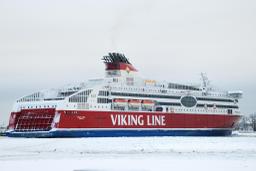Ice class refers to a notation assigned by a classification society or a national authority to denote the additional level of strengthening as well as other arrangements that enable a ship to navigate through sea ice. Some ice classes also have requirements for the ice-going performance of the vessel.
Significance of ice class
Not all ships are built to an ice class. Building a ship to an ice class means that the hull must be thicker, and more scantlings (aggregate of girders, beams, and bulkheads resulting in stronger structural integrity) must be in place. Sea chests (openings in the hull for seawater intake) may need to be arranged differently depending on the class. Sea bays may also be required to ensure that the sea chest does not become blocked with ice. Most of the stronger classes require several forms of rudder and propeller protection. Two rudder pintles are usually required, and strengthened propeller tips are often required in the stronger ice classes. More watertight bulkheads, in addition to those required by a ship's normal class, are usually required. In addition, heating arrangements for fuel tanks, ballast tanks, and other tanks vital to the ship's operation may also be required depending on the class.
Different ice classes
IACS Polar Class
Ships can be assigned one of seven Polar Classes (PC) ranging from PC 1 for year-round operation in all polar waters to PC 7 for summer and autumn operation in thin first-year ice based on the Unified Requirements for Polar Class Ships developed by the International Association of Classification Societies (IACS). The IACS Polar Class rules were developed to harmonize the ice class rules between different classification societies and complement the IMO Guidelines for Ships Operating in Arctic Ice Covered Waters.
Finnish-Swedish ice class
In the Finnish-Swedish ice class rules, merchant ships operating in first-year ice in the Baltic Sea are divided into six ice classes based on requirements for hull structural design, engine output and performance in ice according to the regulations issued by the Swedish Maritime Administration and the Finnish Transport Safety Agency (TraFi). International classification societies have incorporated the Finnish-Swedish ice class rules to their own rulebooks and offer equivalent ice class notations that are recognized by the Finnish and Swedish authorities.Ships of the highest ice class, 1A Super, are designed to operate in difficult ice conditions mainly without icebreaker assistance while ships of lower ice classes 1A, 1B and 1C are assumed to rely on icebreaker assistance. In addition there are ice class 2 for steel-hulled ships with no ice strengthening that are capable of operating independently in very light ice conditions and class 3 for vessels that do not belong to any other class such as barges. The classes can also be spelled with Roman numerals.
Traffic restrictions in the Baltic Sea during winter months are based on the Finnish-Swedish ice class. These restrictions, imposed by the local maritime administrations, declare the minimum requirements for ships that are given icebreaker assistance, for example "ice class 1A, 2000 DWT".
Classification societies
American Bureau of Shipping
The American Bureau of Shipping has a system of ice classes which includes classes A5 through A0; B0, C0, and D0. A5 class is the strongest built of the classes, with D0 being the weakest. All other major classification societies have a similar system of ice classes, and converting between ice classes is relatively easy. In most cases only the names of the classes are changed and the specifics of the Arctic class are identical. ABS Class A5 is the only Arctic Class that may act independently in extreme Arctic waters with no limitations. Other classes are subject to limitations on time of year, required escort (always with a vessel of higher ice class) and ice conditions.
The ABS database includes hundreds of Arctic Ice Classed ships, including many Arctic Research Vessels, and the entire productions of certain shipyards.
Russian Maritime Register of Shipping
The Russian Maritime Register of Shipping (RMRS), established in 1913, has a long history of classing icebreakers and ice-strengthened vessels, and today maintains its own set of ice class rules for vessels navigating in freezing non-Arctic and Arctic seas. Out of about 5,000 vessels classified by the RMRS, over 3,200 are strengthened for navigation in ice and 300 of these have an ice class intended for operations in Arctic waters.The RMRS ice class rules have been revised and the class notations changed several times over the years. As of 2017, the ice classes are divided to non-Arctic, Arctic and icebreaker classes. The ice class notation is followed by a number which denotes the level of ice strengthening: Ice1 to Ice3 for non-Arctic ships, Arc4 to Arc9 for Arctic ships, and Icebreaker6 to Icebreaker9 for icebreakers. These ice classes can be assigned in parallel with the Finnish-Swedish ice class and/or the IACS Polar Class, provided the vessel complies with all applicable rules. The selection of ice class is based on the operating area in the Russian Arctic, time of year, ice conditions, operating tactics, and whether the vessel operates under icebreaker escort or independently. In addition, icebreaker classes have additional requirements for minimum shaft power and icebreaking capability.
Canadian Arctic Shipping Pollution Prevention Regulations (CASPPR)

